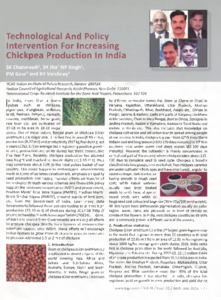Technological And Policy Intervention For Increasing Chickpea Production In India
Abstract
In India, more than a dozen pulses such as chickpea, pigeonpea, mungbean, urdbean, lentil, fieldpea, lathyrus, rajmash, cowpea, mothbean, horse gram, rice bean etc. are cultivated on 27-28 m ha area in 10-12 major states. Out of these pulses, Bengal gram or chickpea (Cicer arietinum L.) is major one. It ranked first in area (8.93 m ha), production (8.37 m t) and productivity (937 kg/ha) during last 5 years (2012-17) on average basis registering positive growth in area, production and yields during last three consecutive Five Year Plans. Recently, chickpea production has attained new height and reached to double digits (>11.10 m t), thus may contribute about 45% to the total pulses basket of our country. This could happen to technological advancements made in terms of varieties development, emphasis on quality seed production and supply, massive efforts on transfer of technologies through various schemes and favourable policy support like minimum support price (MSP) and procurement, Pradhan Mantri Fasal Bima Yojana (PMFBY), Pradhan Mantri Krishi Sinchai Yojana (PMKSY), ensured supply of fertilizers, etc. from the Government of India. Later many state Governments followed these policies leading to all time high production (11.10 m t) of chickpea during 2017-18 (http:// pib.nic.in/newsite/PrintRelease.aspx?relid=176824). Govt, of India and several State Governments are making all efforts to procure chickpea directly from farmers at remunerative minimum support price (MSP). These efforts will encourage Indian farmers to grow more chickpea in years to come and to produce additional 1.5 to 2 m t of chickpea

